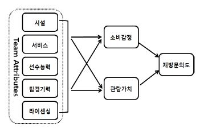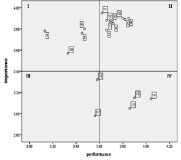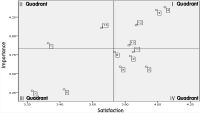
The purpose of this study was to provide managers and owners of Korea professional baseball teams with the necessary information for improving managerial performance by fan acquisition and retention. This paper chose LG, Nexen, and SK fans over the age of 17 as population of this study who visited at least twice home games held in the Jamsil, Mokdong, and Munhak baseball stadium. For the analysis of data, 413 questionnaires were used using SPSS 15.0 Windows and Amos 7.0. To examine respondents demographics traits, frequency analysis was processed and reliability analysis, confirmatory factor analysis and correlation analysis for relationship among the variables were conducted. Also, convergent validity analysis and discriminant validity analysis were made. Finally, path analysis was made for the verification of model suitability and of research hypotheses through structure equation modeling. The research results are as per the below. First, team attributes like physical facilities, team performance and licensing had significantly positive influence on consumption emotion. Second, team attributes like service and team performance significantly positive impact on viewing value. Third, consumption emotion had significantly positive impact on revisit intention. Fourth, viewing value had significantly positive impact on revisit intention.


PURPOSE For student-athletes to be able to successfully dedicate themselves to training and competition, the following key factors play an important role: The coach, team climate, and individual motivational characteristics. To test this hypothesis, the structural relationships between having a perceived autonomy support, a caring climate, basic psychological needs, and sport commitment were analyzed. METHODS Participants were 297 high school athletes registered with the Korea Olympic Committee (203 males, 94 females, Mage=17.88 years). Data were collected using sports climate questionnaires for autonomy support, caring climate scale, basic psychological needs scale, and sport commitment measurement. The collected data were analyzed using descriptive statistics, correlation analysis, and structural equation modeling. RESULTS The model’s fitness was indicated by x2/df=2.797 (x2=106.288, df=38), CFI=.977, TLI=.967, RMSEA=.078 (90% CI=.061, .096). Examining the various path coefficients revealed that coach autonomy support had a positive effect on the athlete’s caring climate, basic psychological needs, and sport commitment. The caring climate had a significant effect on basic psychological needs, but did not have a statistically significant effect on sport commitment. Finally, basic psychological needs had a positive effect on sport commitment. CONCLUSIONS Coach autonomy support fosters a caring climate, and athletes who are able to perceive this are able to dedicate themselves to their sport since their basic physiological needs are met. Therefore, coaches should use appropriate coaching strategies to enhance athletes' autonomy and foster a caring climate, as both are essential factors for meeting athletes' psychological needs and promoting sport commitment.
PURPOSE The purpose of this study was to develop a non-face-to-face self-regulation training program for middle and high school student-athletes through the conduct of a group online video counseling session, as well as to verify the effectiveness of such a tool. METHODS Based on the models of Zimmerman(2000) and Han Si-wan (2008), the 12-session non-face-to-face self-regulation training program consisting of interactions involving cognitive, emotional, and behavioral factors was developed and used on a 16-member experimental group. Additionally, self-regulation and mental toughness questionnaires were given to each member before and after the program, and the results were compared with the results of a 17-member control group. Since a qualitative evaluation was conducted, recorded training contents were organized into a text file; after which, a step-by-step coding procedure was performed, and then meanings and themes were identified and categorized. RESULTS Quantitative analysis found that the volitional inhibition mode of the control group decreased significantly; this was in comparison to the increase in the self-regulation mode of the experimental group. In addition, among the seven sub-factors of the mental strength test of the experimental group, a significant increase was found in the post-test of self-belief, attention control, emotional regulation, resilience, and optimism factors. As a result of qualitative data analysis, they complained of difficulties in the early stages of participation, but gradually recognized their problems and searched for changes, showed changes in cognition, emotion, and behavior as they approached the end of the study period. CONCLUSIONS It can be said that the non-face-to-face self-regulation training program helped student athletes improve their school life and performance by driving positive cognitive, emotional, and behavioral changes.
Purpose Recently, studies associated with the negative physical and mental effects of athletes’ pain have received extensive attention. This study confirmed the validity of the pain catastrophizing scale (PCS) developed in clinical settings and is widely used in the sports field, and examined their relationship between the perceived stress levels and fear of pain. Methods The pain catastrophizing consisted of 13 items of three factors which are Helplessness (6 items), Rumination(4 items), Magnification(3 items). To verify the validity, PSC was revised by following the recommended revision guideline procedures. To test the validation of pain catastrophizing, 206 adult athletes were recruited including the collegiate, professional, and national levels. The participants were instructed to complete questionnaires to assess the level of pain catastrophizing, perceived stress, and fear of pain. Confirmatory factor analysis (CFA) to test the fit of measurement model was adopted to examine three higher-order three-factor measurement models. Results In results, confirmatory factor analysis indicated that the Korean version of the pain catastrophizing scale demonstrated a good model fit of measurement when removing one item with a significantly lower factor load as well as the reliability of the scale was reasonable. The pain catastrophizing had a meaningful positive direct relation with perceived stress level and fear of severe pain. In addition, construct validity and predictive validity of PCS showed valid. Conclusions Based on the results of this study, the Korean sports pain catastrophizing scale can be used to measure the subjective pain intensity of Korean athletes. In addition, it is expected to provide fundamental information for evaluating athletes’ post-injury rehabilitation processes.

Purpose The purpose of this study was to find out what young amateur golfers consider the most when purchasing golf apparel and to find out the Importance-Performance attributes when choosing golf apparel. Methods Amateur golfers in their 20s through 40s who have purchased golf clothing directly were selected as the subject. A total of 350 questionnaires were distributed using the purposive sampling method, and 331 copies as a final validity sample. For data analysis exploratory factor analysis Cronbach’α, frequency analysis, and Importance-Performance analysis by using SPSS 21.0. Results First, except for ‘fancy design’, ‘water-proof function’, ‘elasticity comfort’, ‘brand name’ there were significant differences between importance and satisfaction of selection attribute. Second, ‘harmonic colors’, ‘has its own characteristics’, ‘expressing beauty’, ‘elasticity comfort’ were analyzed to be situated in quadrant Ⅰ. Third, ‘fancy design’, ‘water-proof function’, ‘temperature maintenance function’, ‘elasticity and durability’, ‘brand name’, ‘high-priced yet popular brand’, ‘popular brand’ were analyzed to be situated in quadrant Ⅱ. Fourth, ‘comfortable to wear’, ‘convenient for physical activity’ were analyzed to be situated in quadrant Ⅲ. Fifth, ‘can be also worn for outdoor wear’, ‘wear for gathering’, ‘wear as daily attire’ were analyzed to be situated in quadrant Ⅳ. Conclusions The results will be the basis for effective target marketing on young amateur golfers who are rapidly emerging and will be able to grasp the characteristics of golf apparel that they really want.

Purpose The purpose of this study is to examine the location, rate, cause, and types of injuries according to the injured area by age and sports in female athletes. Methods The subject of the study was 426 female athletes who were registered as combat sports(Judo, Taekwondo, Fencing) athletes at the Korean Sports & Olympic Committee. We collected the data via online questionnaires, and conducted a frequency analysis using R statistics program. Results As a result, 51.4% of athletes experienced injuries in the past year, and the highest injury rate was shown in Taekwondo-University(0.43) during competition and Taekwondo-Professional(5.55) during training. The cause of injuries during competition was mainly due to 'as a result of me or the opponent's hittings, skills, or fouls' among internal factors, and 'recurrent injuries' among external factors. Among internal factors during training except for torso area and professional athletes, most of the injuries were also caused by ‘as a result of me or the opponent's hittings, skills, or fouls’ and ‘recurrent injuries’ among external factors. The frequency of injury was the highest in the lower extremity area across all age groups. The most frequently injured area, in the case of Judo, is skin-bleeding in the head, skin-bruise, muscle-inflammation, bone-fracture, spondylopathy(disc, stenosis, etc.) in the torso, muscle-inflammation in the upper extremity, ligament-sprain, rupture in the lower extremity. Taekwondo athletes had skin-bruise in the head, upper and lower extremities, and muscle-inflammation in the torso area, as the frequent injury cases, and Fencing athletes had all skin-bruise regardless of injuries. Conclusions The results of this study will be used to take measures for preventing injuries or to change training programs.

Purpose The purpose of this study was to investigate differences among perfectionism, anxiety, and aggression in contact and non-contact sports and verify the structural relationship model of perfectionism, anxiety, and aggression in the field of sports. Methods Male college athletes (N=299) participated in the study and perfectionism, anxiety, and aggression questionnaires were utilized after their verification of validity and reliability were conducted. The descriptive statistical analysis, the multivariate analysis, the correlation analysis, the structural equation analysis, and the multi-group analysis were conducted. Results The results are as follows: First, the level of perfectionism, anxiety, and aggression were significantly different between contact and non-contact sports (F=4.316, p<.001). Additionally, subfactors of aggression such as hostility, physical aggression, and verbal aggression factors in contact sports showed a higher average than non-contact sports. Second, perfectionism positively affected anxiety (t=6.936, p<.001) and anxiety positively affected aggression (t=3.380, p<.001). Moreover, the complete mediation effect of anxiety was found in the path from perfectionism to aggression (β=.152, p<.01). Finally, we compared path coefficients between contact and non-contact sports. As a result, positive causal relationships was indicated in the path from anxiety to aggression (β=.511, p<.001) in contact sports. However, it was not discovered in non-contact sports (β=.149, p>.05). Conclusions In conclusion, perfectionism causes anxiety and anxiety is a mediator leading to aggression in sports. Such effect is more predictable and observable in contact sports in which aggression is more favorable and encouraged. Implications and suggestions for future research are discussed.

Purpose The purpose of this study is to investigate the direction of elective courses of high school physical education in preparation for high school credit system by examining the awareness of physical education teachers of general high school and the selection of elective courses by school for elective courses of 2015 revised high school physical education. Methods We surveyed the perceptions of physical education teachers through questionnaires and examined cases of the current status of 65 general high school programs, The results were analyzed by frequency. Results The results of the study are as follows: First, physical education teachers know the purpose of the course, but they know only about the nature of the subject for some subjects. Second, There was little need to open specialized subject courses for general high school students wishing to enter the physical education field. It should be helpful to cultivate 'basic skills for physical education' in selection of elective subject according to the course of physical education. Students in general high schools regarded ‘attention and interest’ as the most important factor when selecting physical education subjects. Third, the selection schedule of physical education elective courses was the highest in <physical education>, and in most schools, 10 to 12 units of physical education degree were organized. Conclusions The conclusion of this study is that the high school physical education elective subjects need to fully reflect the social needs of the physical education and students' preferences, and the physical education and elective courses for general high school students wishing to enter the physical education department should be reconstructed.

Purpose The purpose of this study is to grasp consumers' perception of badminton racket brand image using MDS and ISA. Methods To do this, we conducted questionnaires on those who participated in badminton and had experience of participating for 6 months or more in Seoul and Gyeonggi province from April 12 to 28, 2017, selected and analyzed a total of 313 copies as valid samples of this study. Results The results of study are as follows. First, as a result of MDS analysis, it showed that only the price of brand image attributes were in order of Trion > Joobong > Lining > Victor > Yonex, and the other attributes(Design, Functionality, Quality, Awareness, Advertising image, Event, Color, Popularity, Sophistication, Originality, Trust, Service) were in order of Yonex > Victor > Lining > Joobong > Trion. Second, as a result of ISA analysis, in I quadrant, Yonex showed functionality, quality, sophistication, and trust and Trion showed price, design, functionality and quality, Victor showed price, design, functionality, quality, color, sophistication, trust, service, and Joobong showed price, functionality, quality, and trust in this area. In quadrant Ⅱ as concentrated area, Yonex showed price and service, Trion showed color, trust, service, Victor showed price, Lining showed trust and service, and Joobong showed service in this area. In quadrant Ⅲ as low rank, Yonex showed advertising image, event, Trion showed awareness, advertising image, event, popularity, sophistication, originality, Victor showed advertising image, event, popularity, originality, Lining showed awareness, advertising image, event, popularity, originality, and Joobong showed design, advertising image, color, popularity, sophistication in this area. In quadrant IV as excess avoidance, Yonex showed design, awareness, color, popularity, originality, Victor showed awareness, Joobong showed awareness, event, originality in this area.








Purpose The purpose of this study is to find effective skin scuba activation factors and to provide basic data that extend the scope of research related to skin scuba. Methods Delphi method was used and the experts were categorized by experts to analyze the results. The questionnaires collected through the 2nd and 3rd delphi surveys were SPSS win ver. 22.0 and Microsoft Office Excel 2013 to calculate mean, standard deviation, median, and coefficient of variation. The concrete conclusions are as follows. Conclusions First, in terms of organization sub-factor, fostering sports-for-all participants and college club came out to be very effective and followed by cooperation system with Ministry of Public Safety and Security and Ministry of Oceans and Fisheries, strengthening cooperation and exchange with other education organizations, initializing new scuba diving education organization management and inspection institution and establishing scuba diving education organization. Second, in terms of facility/equipment sub-factor, factors that cause most effectiveness came out as expanding scuba-diving installation, developing connection system with medical department, enlarging indoor-diving education facilities, improving scuba diving equipment, consecutively. Third, in terms of leader sub-factor, training instructor through leader personality education and verification came out to be the most effective, followed by objectifying professional education institution leader training system, improving leader treatment. Fourth, in terms of program sub-factor, it is found that safety education program as the most effective factor, coming next with environment education/professional manpower training program, developing various programs, lastly, inventing insurance product. Fifth, in terms of advertisement sub-factor, as in order of guiding publics to change their view towards scuba-diving, expanding scuba-diving related events and establishing advertisement system had its effectiveness. Sixth, in terms of policy sub-factor, establishing cooperation system among administration departments came out to be most effective and then improving related law-system.